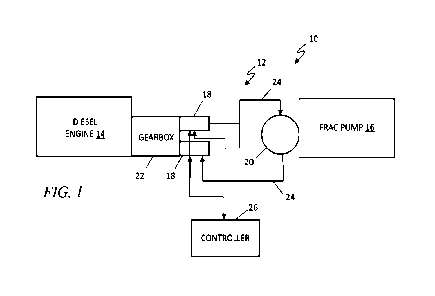Some of the information on this Web page has been provided by external sources. The Government of Canada is not responsible for the accuracy, reliability or currency of the information supplied by external sources. Users wishing to rely upon this information should consult directly with the source of the information. Content provided by external sources is not subject to official languages, privacy and accessibility requirements.
Any discrepancies in the text and image of the Claims and Abstract are due to differing posting times. Text of the Claims and Abstract are posted:
| (12) Patent Application: | (11) CA 3146890 |
|---|---|
| (54) English Title: | HYDRAULIC DRIVE TRAIN FOR A FRAC PUMP |
| (54) French Title: | TRAIN D'ENTRAINEMENT HYDRAULIQUE POUR POMPE DE FRACTURATION |
| Status: | Application Compliant |
| (51) International Patent Classification (IPC): |
|
|---|---|
| (72) Inventors : |
|
| (73) Owners : |
|
| (71) Applicants : |
|
| (74) Agent: | SMART & BIGGAR LP |
| (74) Associate agent: | |
| (45) Issued: | |
| (86) PCT Filing Date: | 2020-07-28 |
| (87) Open to Public Inspection: | 2021-02-18 |
| Availability of licence: | N/A |
| Dedicated to the Public: | N/A |
| (25) Language of filing: | English |
| Patent Cooperation Treaty (PCT): | Yes |
|---|---|
| (86) PCT Filing Number: | PCT/US2020/043913 |
| (87) International Publication Number: | WO 2021030048 |
| (85) National Entry: | 2022-02-03 |
| (30) Application Priority Data: | ||||||
|---|---|---|---|---|---|---|
|
A hydraulic drive system is employed to transfer energy generated by a diesel engine to a frac pump. The hydraulic drive system includes a gearbox comprising a plurality of gears being coupled to and driven to produce rotational movement by the diesel engine, at least one hydraulic pump coupled to at least one gear of the gearbox, and operable to, driven by the rotational movement of the at least one gear of the gearbox, force a fluid at high pressure into at least one high-pressure fluid conduit, and at least one hydraulic motor coupled to the at least one high-pressure fluid conduit to receive the high-pressure fluid, and operable to transform energy in the high-pressure fluid to a rotational movement, which is used to power and drive a plurality of plungers in the frac pump.
La présente invention concerne un système d'entraînement hydraulique qui est employé pour transférer de l'énergie générée par un moteur diesel à une pompe de fracturation. Le système d'entraînement hydraulique comprend une boîte de vitesses comprenant une pluralité d'engrenages accouplés au moteur diesel et entraînés pour produire un mouvement de rotation par celui-ci, au moins une pompe hydraulique accouplée à au moins un engrenage de la boîte de vitesses et pouvant fonctionner de façon à, entraînée par le mouvement de rotation du au moins un engrenage de la boîte de vitesses, forcer un fluide à haute pression dans au moins un conduit de fluide à haute pression et au moins un moteur hydraulique accouplé au(x) conduit(s) de fluide à haute pression pour recevoir le fluide à haute pression et pouvant fonctionner pour transformer l'énergie dans le fluide à haute pression en un mouvement de rotation, qui est utilisé pour alimenter et entraîner une pluralité de plongeurs dans la pompe de fracturation.
Note: Claims are shown in the official language in which they were submitted.
Note: Descriptions are shown in the official language in which they were submitted.

2024-08-01:As part of the Next Generation Patents (NGP) transition, the Canadian Patents Database (CPD) now contains a more detailed Event History, which replicates the Event Log of our new back-office solution.
Please note that "Inactive:" events refers to events no longer in use in our new back-office solution.
For a clearer understanding of the status of the application/patent presented on this page, the site Disclaimer , as well as the definitions for Patent , Event History , Maintenance Fee and Payment History should be consulted.
| Description | Date |
|---|---|
| Inactive: Cover page published | 2022-03-09 |
| Compliance Requirements Determined Met | 2022-03-04 |
| National Entry Requirements Determined Compliant | 2022-02-03 |
| Request for Priority Received | 2022-02-03 |
| Priority Claim Requirements Determined Compliant | 2022-02-03 |
| Letter sent | 2022-02-03 |
| Inactive: IPC assigned | 2022-02-03 |
| Inactive: IPC assigned | 2022-02-03 |
| Inactive: IPC assigned | 2022-02-03 |
| Inactive: First IPC assigned | 2022-02-03 |
| Application Received - PCT | 2022-02-03 |
| Application Published (Open to Public Inspection) | 2021-02-18 |
There is no abandonment history.
The last payment was received on 2024-06-20
Note : If the full payment has not been received on or before the date indicated, a further fee may be required which may be one of the following
Please refer to the CIPO Patent Fees web page to see all current fee amounts.
| Fee Type | Anniversary Year | Due Date | Paid Date |
|---|---|---|---|
| Basic national fee - standard | 2022-02-03 | ||
| MF (application, 2nd anniv.) - standard | 02 | 2022-07-28 | 2022-06-21 |
| MF (application, 3rd anniv.) - standard | 03 | 2023-07-28 | 2023-06-20 |
| MF (application, 4th anniv.) - standard | 04 | 2024-07-29 | 2024-06-20 |
Note: Records showing the ownership history in alphabetical order.
| Current Owners on Record |
|---|
| SPM OIL & GAS INC. |
| Past Owners on Record |
|---|
| BRYAN C. WAGNER |
| JACOB A. BAYYOUK |
| WESLEY P. CLARK |